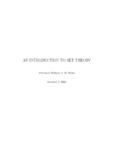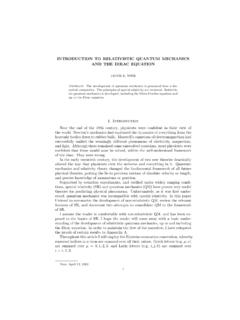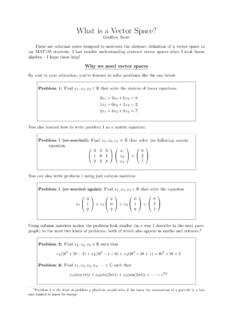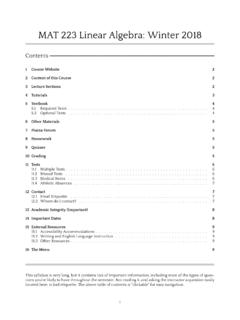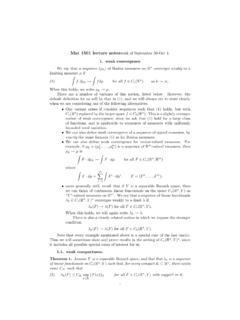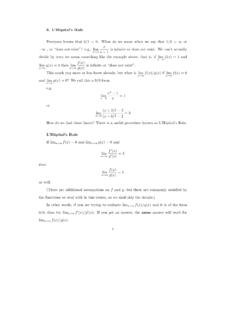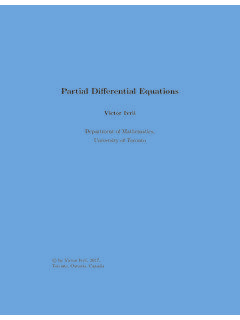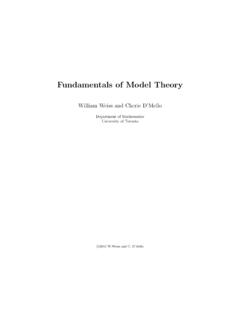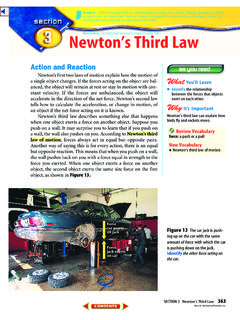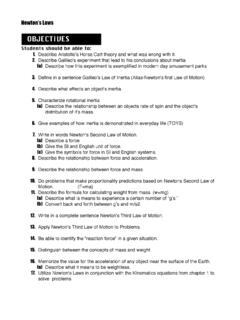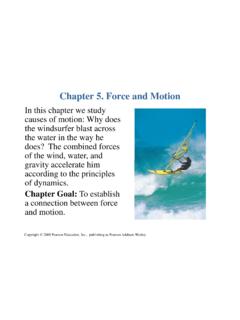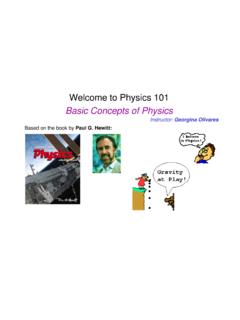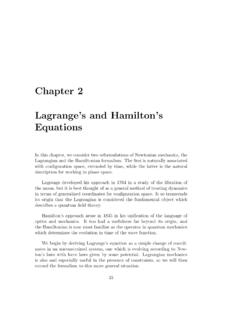Transcription of Mercury’s Perihelion - math.toronto.edu
1 Mercury s PerihelionChris PollockMarch 31, 2003 IntroductionIn 1846, the French Astronomer Le Verriere, doing calcu-lations based on Newton s theory of gravitation, pin-pointed the position of amass that was perturbing Uranus orbit. When fellow astronomers aimed theirtelescopes at his location, they recognized, for the first time, the eighth s theory had reached its zenith. Shortly after, however, it became clearto Le Verriere that additional mass, nearer to the sun than Mercury, was neededto explain the strange advance of Mercury s orbit. When no such mass was ob-served, astronomers began to doubt Newton s theory. Then, along came AlbertEinstein, whose theory nearly perfectly explained Mercury s erstwhile mysteri-ous motion. This essay is a history of Newton s theory of gravity, the enigmaof Mercury, and Einstein s convincing solution.
2 It will blend together mathe-matical and physical theories with a narrative about the brilliant scientists whochose to tackle the problem of gravitation. In particular, this paper will showthe following computations:1. A derivation of Kepler s First Law concerning elliptical orbits from New-ton s Law of Gravitation and Newton s Second An outline of a method to approximate non-relativistic perturbations onMercury s orbit by assuming external planets are heliocentric circles ofuniform linear mass A calculation of relativistic Perihelion shift using Einstein s theory of rel-ativity and the Schwarzschild Theories and IdeasThe problem I set out to explain,the advance of Mercury s Perihelion , was of tantamount importance to the as-tronomical community. This seemingly miniscule enigma stood glaringly in theway of humanity s understanding of the solar system.
3 Let s begin by reviewingthe early evolution of celestial the second century CE, the Greek astronomer Claudius Ptolemy hypoth-esized that the sun, moon, and planets orbited the earth along circles calleddeferents. On a smaller scale, they travelled along smaller circles, called epicy-cles, whose centres moved along the deferents. This theory was sufficientlyaccurate to explain observations of the time. It dominated until around 1843,when Copernicus published his book,de Revolutionibus Orbium solar system was heliocentric but retained the orbital deferents and epicy-cles of Ptolemy s theory. It is interesting to note that Copernicus had difficultyexplaining Mercury s motion and once commented that this planet has .. influenced many perplexities and labours on us in our investigation of itswanderings. (from Baum, 11)More exact naked-eye planetary observations were taken by Tyco Brahe,who, I discovered while writing this paper,did notcut off his own nose.
4 I hadalways believed, courtesy of my eleventh grade science teacher, that the greatDanish observational astronomer removed his nose to allow his face a betterseal with his telescope. My teacher, it turns out, was doubly dishonest since1 Brahe lost part of his nose in a duel with a student and telescopes had not beeninvented in 1600, when Brahe made his young mathematician who worked with Brahe examined the elder s notesand tried to calculate the orbit of Mars. Although an apparently simple task,this was disconcertingly complex since planets appear to change speed and di-rection based on the motion of not only the planet but also Kepler finished his calculations, he determined that Mars moved in anellipse with the sun at one focus. Kepler became quite proficient at predictingMercury s passes between the Sun and Earth, called transits.
5 By hand, hecalculated Mercury s 7 November 1631 transit time, accurate to within five hours(Baum, 15), although he died before witnessing the event he had predicted. Asubsequent transit, on 23 October 1651, was predicted, using corrections ofKepler s calculations, with an accuracy of a few on his planetary observations, Kepler made the following statements,known collectively as Kepler s Laws (Stewart, 897):1. A planet revolves around the Sun in an elliptical orbit with the Sun atone focus2. The line joining the Sun to a planet sweeps out equal areas in equal The square of the period of revolution of a planet is proportional to thecube of the length of the major axis of its so, by the middle of the 17th century, kinematic data on planetary pathswere fairly accurately known. Hence, all of the pieces were on the table for abrilliant theorist (read: Newton) to assemble, explaining the dynamics behindplanetar s LawIssac Newton was born on Christmas Day, 1642.
6 Sincehe was a failure at farming, his mother sent him to university. In the middleof his study at Cambridge, the plage broke out, and the school was closedto students for 1665-1666. Newton returned home, and in this marvellouslycreative period, wrote about both gravitation and calculus. On the formerquestion, he considered a rock twirling around on the end of a string. Therock, he knew, tended to launch, but the string provided a counteracting wondered, then, what provided a counteracting force in the case ofplanetary motion. Could it be gravity, the force that held people on the Earth ssurface?In his magnum opus, 1687 sPhilosophiae Naturalis Principia Mathematice,Newton calculated that the path of planets would be elliptical if they weresubjected to a force of gravitation that varied with the inverse square of theseparation between the planets and the Sun.
7 Starting from Newton s SecondLaw and the Newton s Law of Gravitation, it is possible to prove each of Kepler sLaws. Since Kepler s First Law deals with the elliptical shape of planetaryorbits, a derivation is included below. The discussion that follows is based onChapter of Stewart sCalculus. This is the so-called one-body problem since the system under consideration contains a test particle (the planet) moving2under the attraction of a massive body (the Sun). The planet s mass is assumedto be so small relative to that of the Sun that the Sun remains fixed in , the effects of all other planets are s begin by stating Newton s Second Law:F=ma(1)whereFis the force experienced by the planet,mis its mass, andais Newton s Law of Gravitation:F= GM mr3r= GM mr2u(2)The coordinate system is the force experienced by the planet,Gdenotes the gravitational constant,r=r(t) is the planet s position vector,uisa unit vector in the direction ofr, andMandmare the masses of the Sun andplanet, respectively.
8 Further,r=|r|,v=r , anda=r .First, we will show that the planet moves in a plane. Equating theFs from(1) and (2) givesa= GMr3r(3)henceaandrare parallel, sor a=0 From the properties of cross products, we know thatddt(r v) =r v+r v =v v+r a=0+0=0So, we can conclude thatr vis a constant vector, sayh. We can assumethatrandvare not parallel. This implies thath6=0. We can now concludethatrandhare perpendicular, so the planet always lies in a plane through theorigin perpendicular toh. Planetary motion, according to Newton s Laws, , we can prove examine the shape of the orbit within this plane. Let sstart by rewritingh:h=r v=r r =ru (ru) =ru (ru +r u)=r2(u u ) +rr (u u)=r2(u u )3So, combining the above result with (3) givesa h= GMr2u r2(u u )= GMu (u u )= GM[(u u )u (u u)u ]Sinceuis a unit vector,u u=|u|2= 1, soa h= GM[(u u )u u ](4)Now, let s consider the (u u ) term in (4).
9 Sinceu uis constant,ddt(u u) = 0 u u+u u = 0 u u = 0 Substituting into (4) we geta h=GMu Buthis a constant vector, so(v h) =v h=a h (v h) =GMu Integrating both sides yieldsv h=GMu+c(5)wherecis a constant the planet s motion is confined to an arbitrary plane, we can, withoutloss of generality, call this thexy-plane. Recalling thathis perpendicular to thisplane, let s define a standard basis vectorkin the direction ofh. Looking at (5)and recalling that (v h) anduboth lie in thexy-plane, we can conclude thatcis also in thexy-plane. Let s choose thex- andy-axes such that the standardbasis vectoriis in the direction ofc. There is really nothing special aboutthis choice. Any set of axes would do just fine. Let s go one step further andcall the angle betweencandr. Hence (r, ) is the planet s position in polarcoordinates.
10 If, at this point, it is unclear where we are heading, recall that weset out to show that the planet s path is elliptical. So, ultimately, we re seeking4an expression forr( ). Let s look at an expression forr (v h), substitute in(5), and turn the crank ..r (v h) =r (GMu+c)=GMr u+r c=GM ru u+|r||c|cos =GM r+rccos wherec=|c|.Now, let s solve forrin the previous (v h)GM+ccos Definee=cGM, and substitute into the above equation:r=r (v h)GM[1 +ecos ](6)So, we now have the desired equation forr. Let s simplify the numerator of(6).r (v h) = (r v) h=h h=h2whereh=|h|. So, (6) becomesr=h2GM[1 +ecos ]=eh2c[1 +ecos ]And, for one final simplification, let s renameh2casd. Sor=ed1 +ecos (7)This is the equation of a conic section in polar coordinates. The value ofein the denominator determines the type of conic section (7) represents.

